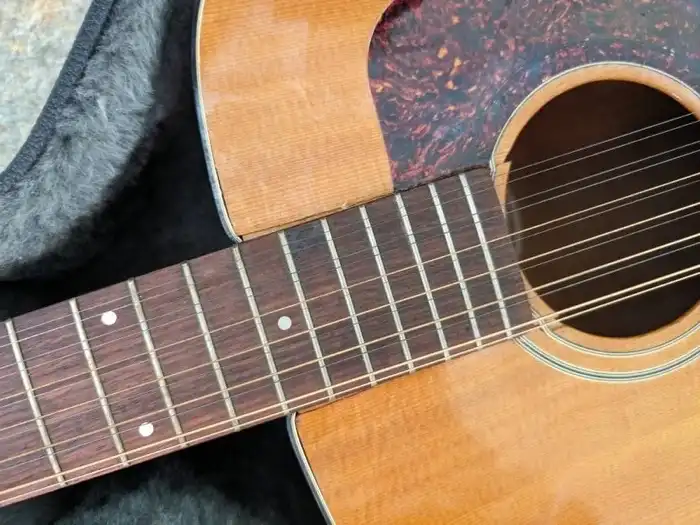1996 Guild D25-12 NT Makeover

A catastrophic neck block shift and soundboard shear on both sides of the fingerboard extension qualifies this guitar for a complete makeover ...

A catastrophic neck block shift and soundboard shear on both sides of the fingerboard extension qualifies this guitar for a complete makeover ...
Thanks to a post from member GGJaguar at the Let's Talk Guild forum, I was made aware of a guitar being offered for sale by an electric player in Florida who had taken the instrument in on a trade. As the story goes, a fellow had purchased this Guild used for $600 years ago in Maine. After relocating, at some point, the guitar made its way to a repair shop in Florida where its owner was informed that "it wasn't able to be repaired." That owner offered it (with additional cash) in trade for an electric guitar.
The gentleman I acquired it from knew the guitar he was taking in on trade was "broken," but had hoped he could perhaps do something with it. After all, it was a Guild, and it was a 12 string! He soon determined that he was not going to be the one to do something with it as, much like the repair shop had indicated to the previous owner, the damage was just too severe. So he put it up for sale and I purchased it with the intention of taking this guitar apart and rebuilding it. My way.
The day has arrived and so has the guitar. It was delivered with no additional damage, thanks to careful packaging (great job, Matt) and expert handling (UPS - when you all do a good job, I am the first to report it!).
The TKL case is in great shape, which is always a good indication of a pleasant and trauma-free journey. My itchy nose, established as one of the world's most sensitive, informs me that this guitar and case were exposed to damp/dank conditions as well as pet dander at some point during the guitar and case's lifespan. A-choo!
The guitar has suffered catastrophic failure at the neck block, which I explore in great detail in my article aptly titled » Body Flexion - Neck Block Shift and Soundboard Shear.

Further inspection reveals the guitar is exactly as the seller described it, and is precisely what I was hoping for. My initial assessment is very positive. A bonus: the arched back is undamaged. Whew!

The neck is in very good condition, straight and showing no signs of splits or cracks.

The headstock looks great. No damage.

Even the mini chrome Grover machine heads are in excellent condition, both mechanically and aesthetically.

If this guitar was ever re-fretted, I sure can't tell. It looks to be untouched.

The bridge is a mere 1/4" high, not at all unusual for a Guild, and the saddle projects a healthy 3/16" above it. Those measurements are approaching the "split out the front of the bridge" range. I need another 1/8" of bridge height on this guitar to make me happy.

In addition to the obvious, elephant-in-the-room neck block shift and soundboard shear at the soundhole, there is some minor damage that is worth noting, as it provides me with a clue as to what happened to this guitar. Can you see the evidence of a fracture in the tailblock? Hint: it appears as a crease that runs right through the center of the end pin.

Also, note the finish fractures that accompany that lower bout impact. They begin at the binding and travel upwards to a point actually directly in front of the bridge.

Playing detective and attempting to retrace the steps of the victim, I would suggest this damage did not occur recently. The blushing of the finish around the neck heel indicates significant moisture was present at some point. There is every possibility that this guitar went largely unplayed its entire life and, one fateful day, was accidentally dropped (either in or out of its case) on its endpin. The sudden shock fractured the tailblock, fractured the finish, and provided sufficient inertia to allow the inadequate support of the upper bout to do what it does best under such situations - which is to permit the neck block to shift forward under string tension and shear the soundboard off into the soundhole, collapsing the surrounding area. If it wasn't already unplayable immediately following the incident, it became so over time.

My first task is to remove everything that isn't nailed down. That means endpin, strings, saddle, nut, and tuners.
Now the guitar can get a thorough cleaning (my nose insisted), and I can have a look inside the belly of this beast courtesy of my endoscope.
This guitar will rest for awhile out of shop rotation before I am able to begin the makeover.
Check back again.